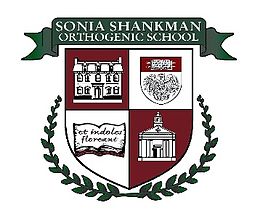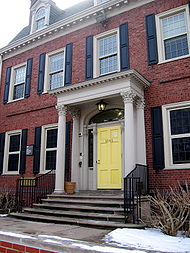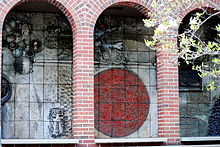- Sonia Shankman Orthogenic School
-
The Sonia Shankman Orthogenic School The front door of the Orthogenic School, with the iconic "yellow door" that has become a trademark of the school. Providing a safe haven and a path to hopeAddress 1365 E 60th St
Chicago, Illinois, 60637
United StatesCoordinates 41°47′8.74″N 87°35′31.2″W / 41.7857611°N 87.592°WCoordinates: 41°47′8.74″N 87°35′31.2″W / 41.7857611°N 87.592°W Information Type Residential treatment center Founded 1915 Grades 6-12 Age 8 to 18 Enrollment 40-60 Average class size 8-10 Student to teacher ratio 4:1 Hours in school day 6 Newspaper 'The Yellow Door Chronicles' Information 773-702-1203 ext. 100 Website http://www.oschool.org 
The Sonia Shankman Orthogenic School, also known simply as the Orthogenic School or informally as the O'School, is a residential treatment center and therapeutic school for children and adolescents typically classified as emotionally disturbed or as having a socio-emotional disorder. The Orthogenic School specializes in the treatment of youth who have failed in other treatment settings.[citation needed] The school is located on the campus of and is affiliated with the University of Chicago.[1]
Contents
Highlights
The school is able to adequately educate students of above-average intelligence and assist students in pursuing advanced courses on an individual or group basis. Students may also attend local universities or private and public schools on a part-time basis. Currently the school is able to treat students in an unlocked setting without utilizing seclusion or medical restraint. Dorm counselors, teachers, and teaching assistants typically have a bachelor's degree and experience in working with young people. Typically the staff to student ratio is very high, with an average of two staff members supervising 5 to 8 students at a time, with support of masters-level staff, educational staff, and crisis intervention staff.
While at school the students have contact with a staff of therapists, program managers, special education teachers, art teachers, teaching assistants, and other professionals. Students with appropriate privileges have the opportunity of going out into the community several days a week, with some students able to leave the school on independent outings into the community.
The school has developed a comprehensive transition program for adolescent students leaving for home, college, or independent living. Students in the Transitional Living Center have the support of the school staff, their old dorm staff, and the transitional living staff. They are typically able to go into the community and pursue employment, educational options, and other community activities. Students stay in the transitional program for periods ranging from several months to two years.
The school is affiliated with the University of Chicago and is located on the campus. Because of this, students are able to utilize many campus facilities during the day.
The school also has several extracurricular programs, including a student work program, student government, a local Junior Achievement charter, a literary magazine and a student newspaper. Students can participate in as many extracurricular activities as they like, so long as their behavior and academic performance are within acceptable boundaries.[1]
Parental Contact
Students attend periodic family sessions with their program manager or individual therapist. The dorm counselors regularly contact parents and update them on their child's progress, and students are able to call home at least once a week and can write as often as they wish. When students gain the appropriate privileges and have demonstrated safe behaviors they can have home visits, typically starting every other weekend and progressing to every weekend during transition phases.
Students who are not able to go home due to distance or behavior may visit their parents at the school or in the local community. Contact with friends may be restricted, although appropriate letter writing is usually encouraged.[1]
Student life
Students live either in communal dorms of up to 7 students per room, in transition rooms, or in a transitional living center. During the school week students attend academic classes during the day and have the option of attending a variety of extra curricular activities in the early evening. Many high school and older middle school students attend departmentalized classes for most of the day. Younger students and students who cannot transition between classes receive individualized and small group instruction in self-contained classrooms.
During their stay at the school students gradually attain to higher levels of privileges, freedoms, and responsibilities, however a formal level system is not used. Behavioral plans, goals, and treatment modalities are utilized on an individualized basis. Students attend one or two 45-minute individual therapy sessions per week and one 60 minute group therapy session per week. A variety of group therapy modalities are utilized such as social skills, process, anger management, transition planning, and depression and anxiety groups.
A day school program is also available. In this, students can attend the school, in additional to receiving group and individual therapy services, but still live at home. The availability and usefulness of this program are decided on a case-by-case basis.[1]
History
The well-known and controversial psychoanalytic theorist Bruno Bettelheim served as director of the Orthogenic School during the mid-twentieth century. During the time he spent there the school became relatively well-known for treating children with autism, a field in which Bettelheim studied.
Bettelheim's method of treating students was unusual for its time. Unlike most hospitals and asylums that functioned much like a medical facility, Bettelheim believed that treatment for mental illnesses should be fundamentally different than treating physical ailments. Doors at the Orthogenic School were always unlocked, and a student could theoretically leave whenever they wanted to. Safety screens on windows were placed on the outside of the window rather than the inside, a bold move for a treatment center at the time. Before arriving at the school a student would have several visits to decide if they wanted to stay. Bettelheim wanted to ensure that a student wanted to attend the school, and would not take children who didn't want to go.Counselors also resided with the students in bedrooms adjacent to their respective dormitories to give round-the-clock support. The counselors, like the students, also attended regular individual and group therapy sessions to allow them to analyze their own methods and thought to improve. This is a practice which continues to this day.
Bettelheim also believed that the Orthogenic School should feel like a home to the students. Furniture in the dormitories was usually antique and very expensive. Students in the dining rooms dined on imported china with metal silverware and glass cups, which was unusual for a treatment center. During the three renovations to the building which Bettelheim supervised, a number of art pieces were commissioned for the school by Bettelheim, including a mural by Jordi Bonet.[2]The Building
A mural at the Orthogenic School, created by Jordi Bonet.
The school is approximately 85 years old and has resided at its current location since the 1940s. The building in which the school resides is much older and has been restored and renovated several times since its occupation. The building itself consists of three segments - a school wing, a dormitory wing, and a "transitional wing" which houses various student-used spaces. Parts of the building are also used by the Hyde Park Day School, a school for children with learning disabilities.[3]
Recently it was decided by the school's Board of Trustees to move the school's facilities to a new building. The school is expected to complete construction of the new building by 2011. The school is not expected to leave the Hyde Park, Chicago neighborhood as a result of its relocation.[citation needed]
References
- ^ a b c d "Sonia Shankman Orthogenic School". http://www.oschool.org/. Retrieved 21 December 2008.
- ^ Bettelheim, Bruno (1974). A Home for the Heart. Knopf.
- ^ "Welcome to Hyde Park Day Schools!". http://hpds.uchicago.edu/. Retrieved 21 December 2008.
External links
Categories:- Schools of the University of Chicago
- Healthcare in Chicago, Illinois
Wikimedia Foundation. 2010.



